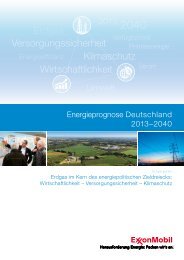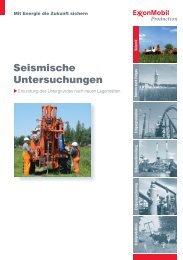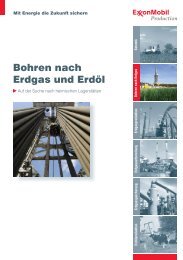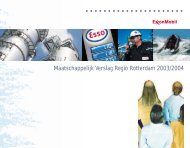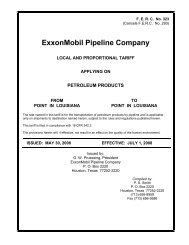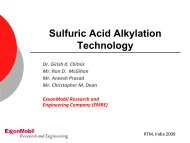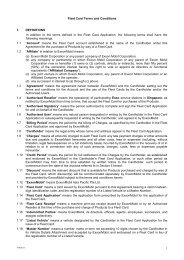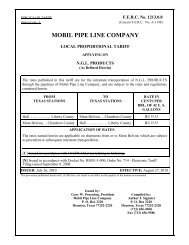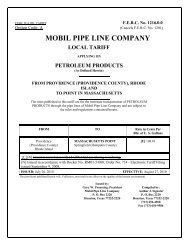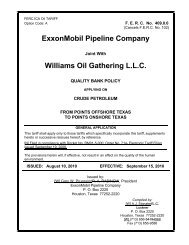Number 4 - ExxonMobil in the UK
Number 4 - ExxonMobil in the UK
Number 4 - ExxonMobil in the UK
Create successful ePaper yourself
Turn your PDF publications into a flip-book with our unique Google optimized e-Paper software.
Access to domestic resources<br />
Some federal lands and offshore areas <strong>in</strong> federal waters<br />
have been off limits to <strong>the</strong> oil and gas <strong>in</strong>dustry for more<br />
than 20 years. In 2008, Congress and <strong>the</strong> president lifted<br />
those bans, although state restrictions still apply. Does<br />
that mean <strong>the</strong> United States can now achieve energy<br />
self-sufficiency?<br />
No, says Tim Cejka, president of <strong>ExxonMobil</strong><br />
Exploration Company, but that’s not <strong>the</strong> po<strong>in</strong>t.<br />
“Drill<strong>in</strong>g <strong>in</strong> <strong>the</strong>se newly opened areas won’t solve price<br />
and supply issues overnight,” he says. “But open<strong>in</strong>g<br />
<strong>the</strong>m up can be an important part of <strong>the</strong> larger solution<br />
to meet<strong>in</strong>g <strong>the</strong> nation’s energy needs.”<br />
Cejka po<strong>in</strong>ts out that <strong>the</strong>re is no s<strong>in</strong>gle solution to<br />
meet<strong>in</strong>g <strong>the</strong> nation’s energy challenges.<br />
“Increased drill<strong>in</strong>g, both domestically and globally,<br />
comb<strong>in</strong>ed with technology, development of alternative<br />
energy sources and improved energy efficiency, builds<br />
<strong>the</strong> best path forward,” he says.<br />
What challenges does<br />
Exploration face <strong>in</strong> high- and<br />
low-price environments?<br />
The Exploration Company has<br />
two overarch<strong>in</strong>g objectives. One<br />
is to be safe, ethical and environmentally<br />
sensitive <strong>in</strong> everyth<strong>in</strong>g<br />
we do. The second is to add<br />
resources to <strong>the</strong> corporation’s<br />
<strong>in</strong>ventory that exceed production<br />
<strong>in</strong> any bus<strong>in</strong>ess environment.<br />
It’s all about constancy of<br />
purpose. As o<strong>the</strong>r companies<br />
trim back budgets and activities<br />
due to <strong>the</strong> economic crisis,<br />
we will execute our exploration<br />
program as planned to add new<br />
resources and actively pursue<br />
new opportunities. In fact, our<br />
plan and budget for <strong>the</strong> next few<br />
years is <strong>the</strong> most active s<strong>in</strong>ce <strong>the</strong><br />
merger, with a record number<br />
of operated wells target<strong>in</strong>g highpotential<br />
opportunities <strong>in</strong> new<br />
areas around <strong>the</strong> world.<br />
Does <strong>ExxonMobil</strong> pursue<br />
specific resource types?<br />
We pursue most types of<br />
resources. We look for conventional<br />
oil and gas as well as<br />
remote gas that will have to be<br />
commercialized such as LNG<br />
[liquefied natural gas]. We’re active<br />
<strong>in</strong> heavy oil, tight gas, oil shale<br />
and shale gas.<br />
Our goal is to be <strong>the</strong> best <strong>in</strong><br />
each resource type. This diversity<br />
<strong>in</strong>creases <strong>the</strong> strength of our<br />
portfolio.<br />
Where are <strong>the</strong> new opportunities<br />
for <strong>ExxonMobil</strong>?<br />
We’ve been <strong>in</strong> <strong>the</strong> Arctic for<br />
some time, and some <strong>in</strong>terest<strong>in</strong>g<br />
new opportunities are start<strong>in</strong>g to<br />
open up. The Canadian Beaufort<br />
Sea is a good example. When<br />
<strong>the</strong> government’s tender offer<br />
recently came up, we were ready<br />
to move because we had already<br />
decided we wanted to<br />
be <strong>in</strong> that area. As a<br />
result, we were able to get a very<br />
large, high-potential block <strong>in</strong> <strong>the</strong><br />
Canadian Beaufort Sea.<br />
We’ve been <strong>in</strong> Greenland for<br />
more than 20 years. Recently,<br />
we looked at some regional<br />
studies we’d done. There was a<br />
potential oil seep onshore western<br />
Greenland, which suggested<br />
<strong>the</strong> presence of good source<br />
rock. We sampled <strong>the</strong> oil and<br />
decided <strong>the</strong> area had potential,<br />
and now we have two blocks <strong>in</strong><br />
<strong>the</strong> western offshore.<br />
In Brazil, we’re drill<strong>in</strong>g an<br />
exploration well <strong>in</strong>to a very large<br />
structure. There have been<br />
some encourag<strong>in</strong>g discoveries <strong>in</strong><br />
<strong>the</strong> area, so we’re hopeful about<br />
<strong>the</strong> outcome.<br />
The situation <strong>in</strong> New Zealand<br />
is far more uncerta<strong>in</strong>. A few<br />
noncommercial gas discoveries<br />
have been made <strong>in</strong> <strong>the</strong> Great<br />
South Bas<strong>in</strong>, and <strong>the</strong> assumption<br />
had been that <strong>the</strong> bas<strong>in</strong> was not<br />
prospective. We <strong>in</strong>cluded that<br />
bas<strong>in</strong> <strong>in</strong> a major regional study<br />
and discovered it had areas that<br />
might hold natural gas. We also<br />
saw <strong>in</strong>formation on a previous<br />
seismic survey that appeared to<br />
be a direct hydrocarbon <strong>in</strong>dicator.<br />
Subsequently, we leased a very<br />
large block.<br />
In Indonesia, we took our<br />
onshore success at Cepu and<br />
asked ourselves whe<strong>the</strong>r that<br />
To learn more<br />
exxonmobil.com/<br />
technology<br />
play could cont<strong>in</strong>ue offshore.<br />
When we looked,<br />
we saw some very good <strong>in</strong>dications<br />
of hydrocarbon-bear<strong>in</strong>g formations.<br />
We went to tender and<br />
won several leases with plans to<br />
drill <strong>in</strong> early 2009.<br />
What advantages does<br />
<strong>ExxonMobil</strong> have over our<br />
competitors <strong>in</strong> pursu<strong>in</strong>g<br />
exploration opportunities?<br />
First of all, our people – we have<br />
<strong>the</strong> best <strong>in</strong> <strong>the</strong> <strong>in</strong>dustry. The<br />
same is true of our technology<br />
and f<strong>in</strong>ancial strength.<br />
In addition, our global comput<strong>in</strong>g<br />
systems and global<br />
reach have given us a significant<br />
advantage. They enable us to<br />
look at <strong>the</strong> characteristics of a<br />
successful field <strong>in</strong> one part of<br />
<strong>the</strong> world and to search for a<br />
field with <strong>the</strong> same characteristics<br />
<strong>in</strong> ano<strong>the</strong>r region.<br />
I like to use <strong>the</strong> example of<br />
<strong>the</strong> “five whys.” When someone<br />
puts forward a proposal, <strong>the</strong> first<br />
question is “Why would you do<br />
that?” That’s usually pretty easy<br />
to answer. And <strong>the</strong>n you ask a<br />
second, deeper “why,” and it’s a<br />
little harder to answer. You ask<br />
<strong>the</strong> third “why,” <strong>the</strong>n <strong>the</strong> fourth<br />
and <strong>the</strong> fifth, and each question<br />
gets tougher. What you f<strong>in</strong>d is<br />
that <strong>ExxonMobil</strong> people have<br />
<strong>the</strong> courage and confidence to<br />
handle <strong>the</strong> fifth “why.” <strong>the</strong> Lamp<br />
8




